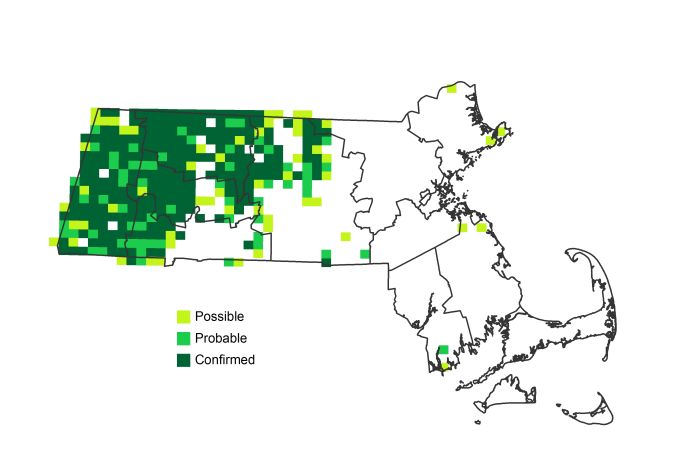Find a Bird
Yellow-bellied Sapsucker
Sphyrapicus varius

Somewhat local and strongly increasing
“What else could it be? It’s got a yellow belly and it was sucking sap!” – Ed Norton, The Honeymooners
Due to its novel name, the Yellow-bellied Sapsucker has become a near-mythical creature, often cited by characters in popular media to demonstrate their knowledge of trivia or birding ability. While by no means mythical, in reality these birds have not always been easy to find in Massachusetts. Following the destruction of much of the state’s forest cover, Yellow-bellied Sapsuckers were a rare breeding species in the Bay State. These days, they look to be staging a comeback in Massachusetts as newly maturing forests reclaim the land once held by earlier generations of old-growth forest.
Historic Status
William Brewster only remembered ever seeing one Yellow-bellied Sapsucker near his home in Cambridge in winter, while on an outing with Daniel C. French in 1862 (Brewster 1906). Sapsuckers, like most woodpeckers, require forests to thrive, and Massachusetts at that time was a farming society. Eastern Massachusetts, in particular, was about a century away from attracting large woodpeckers in summer or winter on a regular basis. But western Massachusetts was on its way; as forests returned to the higher elevations, the Yellow-bellied Sapsucker population increased. By the 1950s sapsuckers were recognized as rare and local breeders west of the Connecticut River Valley, though they were weirdly absent from eastern Massachusetts even during migration, despite the fact that they bred commonly in the three New England states to the north (Petersen & Meservey 2003).
Atlas 1 Distribution
The Atlas 1 distribution was heavily weighted toward the western half of the state, with the concentration of Yellow-bellied Sapsuckers peaking in the Berkshire Highlands region at 89% block occupancy. The far Taconics had sapsuckers in three-quarters of all blocks, and the birds were present in more than 50% of the blocks in each of the Marble Valleys, the Lower Berkshire Hills, the Vermont Piedmont, and the Berkshire Transition regions. The nearby Connecticut River Valley, dominated as it was by lowland agricultural habitat, presented a formidable barrier for this species. Fewer than a dozen occupied blocks were found east of the Connecticut River Valley, with 9 of those occurring on the relatively high and relatively forested Worcester Plateau.
Atlas 2 Distribution and Change
Even today, the Yellow-bellied Sapsucker is typically thought of as a breeder of western Massachusetts, although they are steadily expanding eastward. The species was already widespread in the west during Atlas 1, and by Atlas 2 it seems to have established itself in nearly every block on that side of the Connecticut River Valley. Some expansion was also evident in the northern Connecticut River Valley. The species’ growth into the Worcester Plateau, where it had only a small foothold in Atlas 1, was the most remarkable change in its distribution. In just a few decades, Yellow-bellied Sapsuckers expanded from just 9 Worcester Plateau blocks (about 11% of the region) to 72 (about 82% of the region). Sapsuckers also colonized the Lower Worcester Plateau to a lesser extent, but they had a very limited presence in eastern ecoregions such as the Coastal Plains and Bristol/Narragansett Lowlands.
Atlas 1 Map

Atlas 2 Map

Atlas Change Map

Ecoregion Data
Atlas 1 | Atlas 2 | Change | ||||||
Ecoregion | # Blocks | % Blocks | % of Range | # Blocks | % Blocks | % of Range | Change in # Blocks | Change in % Blocks |
Taconic Mountains | 12 | 75.0 | 7.8 | 23 | 92.0 | 6.7 | 3 | 20.0 |
Marble Valleys/Housatonic Valley | 22 | 56.4 | 14.4 | 35 | 89.7 | 10.1 | 13 | 33.3 |
Berkshire Highlands | 49 | 89.1 | 32.0 | 55 | 100.0 | 15.9 | 12 | 22.6 |
Lower Berkshire Hills | 21 | 75.0 | 13.7 | 30 | 96.8 | 8.7 | 5 | 18.5 |
Vermont Piedmont | 11 | 64.7 | 7.2 | 17 | 100.0 | 4.9 | 1 | 8.3 |
Berkshire Transition | 24 | 63.2 | 15.7 | 40 | 100.0 | 11.6 | 12 | 38.7 |
Connecticut River Valley | 3 | 5.4 | 2.0 | 23 | 35.4 | 6.7 | 12 | 25.0 |
Worcester Plateau | 9 | 11.5 | 5.9 | 72 | 81.8 | 20.9 | 32 | 66.7 |
Lower Worcester Plateau | 1 | 1.4 | 0.7 | 31 | 38.8 | 9.0 | 16 | 29.6 |
S. New England Coastal Plains and Hills | 1 | 0.4 | 0.7 | 17 | 6.0 | 4.9 | 8 | 3.5 |
Boston Basin | 0 | 0.0 | 0.0 | 0 | 0.0 | 0.0 | 1 | 1.8 |
Bristol and Narragansett Lowlands | 0 | 0.0 | 0.0 | 2 | 1.8 | 0.6 | 2 | 2.0 |
Cape Cod and Islands | 0 | 0.0 | 0.0 | 0 | 0.0 | 0.0 | 0 | 0.0 |
Statewide Total | 153 | 15.8 | 100.0 | 345 | 33.3 | 100.0 | 117 | 14.1 |
Notes
In accordance with Atlas increases, the Yellow-bellied Sapsucker shows significant increasing Breeding Bird Survey trends in Massachusetts and in the New England/Mid-Atlantic Region.



